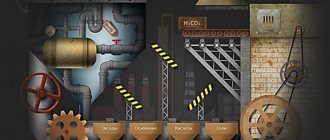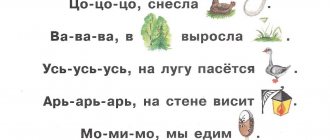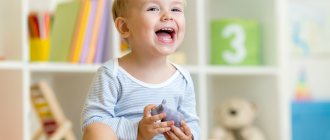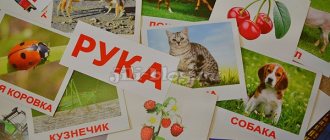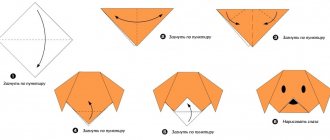Gross motor skills are a set of skills that require the use of the major muscles of the body to perform. We use these skills every day: we go to the store, run after the baby on the playground, pick up toys from the floor, make the bed. The list can be continued endlessly: we don’t attach much importance to everyday movements, we do them automatically. Although everything is a little more complicated than it seems at first glance.
Gross motor skills regulate muscle and nervous system function and are responsible for coordination and balance. This is also the basis of fine motor skills, which will help the baby make smaller movements with his hands and fingers.
Note to moms and dads:
By following the link you can watch a short video about gross and fine motor skills from Doctor of Medical Sciences and pediatric neurologist Alexey Igorevich Krapivkin.
What gross motor skills should children of different ages have?
Now we will talk about general age standards, but remember that each child is unique. If you are concerned about your baby's physical development, it is best to contact your pediatrician.
0-3 months
- holds head while lying on stomach
3-6 months
- can roll over from back to side
- rolls over completely: from tummy to back and vice versa
6-9 months
- makes his first attempts at sitting with your support
- sits by himself
- “slides” with his tummy, tries to get on all fours
- starts to crawl
1 year old
- pulls himself up to stand
- takes its first steps, holding on to you for 2 years
- walks (sometimes falls)
- runs (also not without falling)
- jumps on two legs
3 years old
- can stand on one leg
- goes up and down the steps holding your hand
- learning to climb the climbing frames on the playground
More information about the average norms for a baby’s weight, height and behavior is in the Development Calendar from FrutoNyanya. You can go to it using the link
Fun exercises for babies
This is my toy!
An activity option for a child who already knows how to grab and hold objects. When the baby is lying in the crib, put a soft rattle in his hands and gently, weakly pull it towards you. Let the baby try to pull the toy towards him. This exercise allows you to train your biceps, which are responsible for bending your arms at the elbow and turning your hands.
Expedition for children's treasures
Place your baby's favorite toys around the room or playpen and give him freedom of movement: let him try to crawl to his favorite bunnies, blocks and pyramids. This will awaken the child's interest in independent movements.
Multi-colored leaves
The exercise is suitable for babies who are already making their first attempts to stand on their feet, holding onto the sides of the crib. Glue several colored stickers on the wall next to the crib - they should be inaccessible from a sitting position. But it should be easy for the baby to get them by standing on his feet. Your little one will surely enjoy tearing leaves off the wall. Do not leave your child with stickers unattended.
Finger games
Finger games will help children:
- make a breakthrough in speech development - improve pronunciation and enrich vocabulary;
- prepare your hand for writing;
- develop attention, patience, the so-called internal brake - the ability to restrain yourself exactly when it is necessary;
- stimulate imagination, show creativity;
- learn to control your body, feel confident in the system of “bodily coordinates,” which will eliminate the possibility of neuroses.
Fun exercises for older kids
Even simple exercises may have their contraindications depending on the developmental characteristics and health status of the baby. Therefore, before performing such exercises, it is necessary to consult with the pediatrician who is observing the baby. For example, diseases of the cardiovascular system may be a contraindication to active games and running. Allergic diseases require caution when using solutions for soap bubbles and playing with pillows (due to house dust); diseases of the musculoskeletal system limit riding a scooter or bicycle.
Catching up with soap bubbles
This game is suitable for kids who already walk and run confidently. On a walk or at home, blow soap bubbles and invite your baby to pop them with his palms.
It is impossible to predict the flight path of a soap bubble - that is why, trying to catch up with it, the baby will quickly change his movements, jump or, conversely, dodge.
Obstacle course
For this exercise we will need a balance bike, tricycle or scooter. Make obstacles out of plastic cones and invite your child to go around them. Another option for the exercise: draw a white line on the asphalt and ask your child to drive along it as smoothly as possible.
Aerialist
This is a home version of the chalk line exercise. Just place masking tape on the floor and let your little one walk across it with his arms outstretched. In addition, you can come up with a gaming legend. For example, that the ribbon is stretched high, high above the clouds, and the peaks of snow-white mountains are hidden under the legs.
Development of fine motor skills in children
Exercises after 3 years
Beads and cereals
This category includes games with small objects. It can be anything - beads, beads, various cereals, etc.
You can start with larger items. For example, large beads that a child will play with great interest in his hands.
Another option is cereals. Pour buckwheat or other cereal into a bowl and give it to your baby. He will touch it, roll it in his fingers. In this way, children develop tactile sensations and fine motor skills well.
You can add some kind of goal to these activities. For example, pour buckwheat onto the table and ask your child to separate the black grains from normal buckwheat. You can also ask him to sort the beads by color.
Screwing and unscrewing lids
Developing fine motor skills by screwing or unscrewing bottle caps (it’s better to choose different sizes) is a good exercise for developing dexterity in children’s fingers.
A similar effect is achieved by unfastening and fastening zippers and buttons. In addition, this way the child quickly learns to be independent. You can gradually develop in your child the understanding that he must button his own jacket, lace his shoes, etc.
Modeling
It is suitable for children of different ages. You can use different materials - plastic dough, plasticine, clay. Try to add variety to your classes every time. For example, if at first you just give your child plasticine, and he tries to mold something out of it, then later you can add some objects to the lessons and tell your child to stick plasticine around them. Handprints and various objects can be made from clay.
Parents can be advised to take their child with them to the kitchen when you want to bake something. Let your baby work with the dough, knead it with his hands, but be careful and remove all sharp objects.
Sand games
There are many different variations possible here. The child can draw with his finger in the sand, you can hide some objects and ask the child to find them in the sand. Such activities are only suitable for children over 3 years old, because young children put everything in their mouth.
Drawing, cutting, puzzles, construction sets
Cutting out figures and various objects from paper has an extremely beneficial effect on the development of fine motor skills. Here you need to start with something simple (cutting out shapes with straight lines) and move on to something more complex (cutting out shapes with curved lines, snowflakes, etc.). Carving is also useful because it develops spatial perception.
The same goes for drawing. At first, you can simply give your child a felt-tip pen and full scope for creativity. Then ask him to complete the missing part of the drawing, draw a line along the contours, etc.
Construction sets and puzzles not only develop fine motor skills, but also have a beneficial effect on a child’s imagination, memory and creativity. In addition, the baby develops patience and perseverance. There are a large number of options on sale for children of different ages.
Period from 2 to 3 years
The period from 2 to 3 years is an extremely important stage in a child’s life, in particular, in intellectual and cognitive development.
As you know, the organ of thinking, the organ of all mental activity of a person, is the brain. During the development of a child, when the growth of brain cells occurs, their formation, when the nerve fibers quickly grow - the pathways that connect the brain with the sense organs and with the muscles, during the contraction of which various movements occur, the increase in brain mass is of great importance.
The most intensive enlargement of the brain in early and early preschool age indicates that it is at this time that children develop especially quickly. And indeed, how much knowledge and skills a child acquires during the first three years of his life!
He learns to look and listen, talk, grasp objects and act with them, stand, walk, run, jump, go down and up stairs. The child also masters numerous skills - using a spoon, brush, pencil and many other objects.
The child’s memory is enriched with a huge amount of knowledge about colors and sounds, about natural phenomena and objects, the properties of various objects and products of human labor. The baby learns space and time, masters speech, learns to communicate with adults and peers, and learns the basic rules of behavior.
The importance of early age for the development of motor skills of a future personality
Hands are a delicate instrument, and they “tune” over a long period of time. Therefore, work on developing the baby’s hand movements needs to begin from birth. After all, a child, even at the age of an infant, and especially at an early age, has enormous potential for the formation of a future personality, in particular its intellectual development.
It is at an early age that a child can gain a lot, but also lose a lot. It should be noted that losses of this period are more difficult to compensate with age, but gains remain for life.
Do not forget that it is in the first three years of life that the brain develops most intensively: by seven months, a child’s brain doubles in size, at one and a half years - three times, and by three years it already accounts for 3/4 of the mass of an adult’s brain.
Games in kindergarten and at home
In a preschool, children usually have a place and time to play. Parents of the child should also take care of these things necessary for the baby’s mental development in speech at home. It is useful when dad or mom encourage the child to play, tell and show him exactly how to play with this or that toy.
Play is a kind of school of life and a path to the development of children's creativity, independence, acquisition of communication skills, and the like.
Listening to poems and fairy tales, a child learns a lot of new and interesting things about the world around him, trees and flowers, people and animals, fantastic heroes, their amazing adventures, etc.
Naturally, 2-3 year old children cannot immediately understand what an adult told them. Therefore, children often require repeated repetition of the same fairy tales, stories, nursery rhymes, songs, and poems.
Such repetition plays an important role: it gives the child the opportunity to think about the plot of what he heard. If a child is offered more and more new books, he will get used to superficial familiarization with them from childhood.
The main thing is that the child learns to understand what he listened to. To do this, it is important to ask questions: what (or who) is the poem or fairy tale talking about?
Sometimes, after reading, it is useful for an adult to ask the child: “Who did we read about today?”, “What did he do?”, “What happened to him?”, “How did the fairy tale end?” Such questions force the child to think about what he read.
Similar work can be done using pictures, when children look at illustrations in books or individual pictures with a certain plot. It is advisable to ask a child of primary preschool age: “What is this?”, “What is drawn here?”
An important means of not only understanding the world around us, but also children’s communication with each other is the acquisition of speech. Therefore, it is necessary to develop in the child not only his understanding of adult speech (passive speech), but also his own, active spoken speech.
An adult has many opportunities for this. It is imperative to monitor the purity of the child’s speech, the correct use of words by the child and the construction of sentences.
Motor problems
Many parents understand the need for a child’s development from birth and work with their children with great interest. But for classes to be effective and for the baby to enjoy them, they must always be interesting, fun and must be appropriate for the baby’s age.
Each of us has encountered children four to five years old who hold a spoon in their fist, do not know how to properly hold a brush or pencil, use scissors, sometimes cannot fasten buttons, lace shoes, tie a scarf, and the like.
It is no secret that some parents find it easier to sit their child in front of the TV or at the computer, turning on a full-length cartoon or playing a game for an hour, so that the child is not distracted from talking on the phone with a friend or other adult activities.
Only some parents admit the fact that it is difficult for them to calmly wait until their child laces his shoes, buttons all the small buttons on his shirt, finishes his porridge, and the like.
Therefore, they buy Velcro boots instead of shoes with laces, a sweater with a zipper instead of a shirt, and feed the child themselves in order to free up time for other things. Few parents think about the fact that such time savings deprive their child of the opportunity to develop finger movements, and, consequently, improve the quality of broadcasting.
